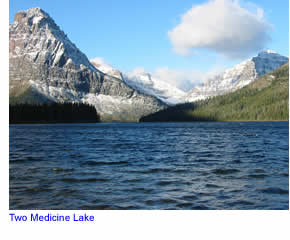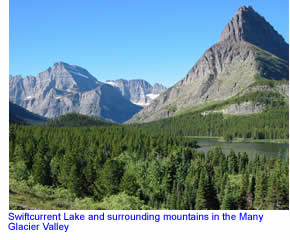
Glacier National Park
Grizzly Bear Information

 |
Glacier National Park
|
 |
| Home > Glacier National Park > Grizzly Bears > Surviving a Confrontation | Search Site |
Glacier National Park
|
Surviving a Grizzly Bear Confrontation
|
 |
| Photo Use Guidelines |
All of the information on the previous page should help hikers, whether hiking alone or in a group, avoid most unpleasant bear confrontations. However, from time to time, even large groups come across grizzly bears right on the trail. What to do when you come across a grizzly bear when hiking in Glacier National Park is covered in this section. It is worth noting that bears are wild creatures and thus do not behave predictably. While the tactics below should work for most bear encounters, they won't always work!
First, and by far the most important, is to never, ever run away from a grizzly bear. Period. If you happen across a grizzly bear on a hiking trail, turn your back on it and start running away like a track star, you will only be inviting trouble to follow. By running away, you will almost certainly trigger the grizzly bears chase response. Moreover, running away is a useless gesture anyway. At best, you can probably run no more than 15 miles per hour, far less if uphill or through brush or when wearing a pack. A grizzly bear can hit speeds of 40 miles per hour. Thus, no matter how hard you run, a grizzly bear can out-run you and will most likely catch you before you get a hundred feet. Thus, never run away from a grizzly bear. Doing so only invites trouble to follow.
Attempt to measure the grizzly bears mood. By this I mean notice how the bear looks and how it reacts to your presence. Does the bear have its' ears laid back - sort of like an upset dog? If so, then you have an aggressive and angry bear on your hands, which is not good news. On the other hand, does the bear stand up on its' rear legs or perk its' ears up? If so, that is good news, as you only have a curious bear on your hands. Noticing the grizzly bears mood is very important as it goes along way in determining how to react.
For curious grizzly bears, what has worked for me on two occasions is to do nothing at all. By this, I mean don't approach the bear, but don't run away or even back away from it. Instead, just stand there and see what the bear does, doing your best to show absolutely no fear at all. Most likely, the bear will do one of two things - it will either ignore you or it will go away - at least getting off the trail.
It seems less than logical to not back slowly away from a curious grizzly bear. However, I had an experience that made the "back away slowly" approach work less than spectacularly. While hiking the Numa Lookout Trail, near Bowman Lake, I came across a grizzly bear about 30 yards away. The bear noticed me at the same time I noticed it. I just stood there while the bear curiously looked me over. The grizzly bear than slowly began to make its way off the trail, satisfied that I posed it no threat. I then made the mistake of backing away from the grizzly bear, on the assumption that I should give the bear more "space". And guess what? The grizzly bear got back on the trail and began to follow! As I continued to back away, the bear continued to follow, keeping an equal distance between us. After a hundred yards of this, I had enough. I stopped backing away, held my place on the trail, and started talking to the grizzly bear like a long lost friend. Almost immediately, the grizzly bear immediately vacated the trail. I stood there till the bear got about 30 yards off the trail and then continued on my way.
 |
| Photo Use Guidelines |
Looking back on this incident, I suspect this is what happened. The grizzly bear saw I posed no threat, so it went back to doing what it was doing. When I started backing away, it aroused the curiosity in the bear - it probably was wondering why I was backing away since it made no aggressive movements towards me (after all, this bear was curious, not aggressive). So, the bear decided to follow to see what was up. When I stopped in the trail and started talking to it, it must have satisfied its curiosity and decided to go about its business. This incident could also have ended much differently. I believe that if I would have continued backing up, or would have played dead, climbed a tree or ran away, the bears instinct to investigate further or to give chase may have been triggered, leading to an ugly confrontation.
All of this is fine and good for curious grizzly bears. However, what do you do if you have an aggressive grizzly bear on your hands? You'll know if you have an aggressive bear on your hands if it has its ears laid back or if it starts chomping its jaws. For aggressive bears, it is highly recommended by most people who study bears to gradually back away from the bear. Holding your ground against an aggressive grizzly bear, at least before it decides to charge, is probably a good way to invite a charge. After all, the bear is aggressive. If you decide to hold your ground the grizzly bear may consider that a challenge and charge. Thus, when confronted by an aggressive grizzly bear, attempt to slowly retreat away, never turning your back to the bear and also avoiding eye contact if possible.
Generally, the back away approach usually works for aggressive bears. However, from time to time, the grizzly bear may decide to charge anyway. Having first hand experience, I can tell you that seeing a very large grizzly bear storming at you is not a real pleasant sensation - although you won't soon forget it! There are a number of things you can do. Which one you do really depends on your personality, your surroundings and how far away the grizzly bear is. Here are several methods you can use to thwart a charging grizzly bear.
First, drop something, not food, on the trail between you and your charging grizzly bear. Frequently, the grizzly bear will stop to investigate what you just dropped on the trail.
A second method is to just drop and play dead. This sound easier than it really is. Unlike in cartoons, grizzly bears usually do much more than just sniff you when playing dead. It is quite common for them to pick you up, turn you over as well as bite you. It takes a lot of courage to remain perfectly motionless and quiet when a grizzly bear is handling you in a physical and painful way. However, many people have survived grizzly bear charges this way so it is a method that is time tested.
 |
| Photo Use Guidelines |
A third method is to hold your ground. Many if not most grizzly bear charges are bluff charges. They are charging you to get you to run away or to get you to react. By holding your ground and hiding all fear, the grizzly bear is likely to stop their charge - sometimes just a few feet away.
However, just because they stop their charge and retreat does not mean the confrontation is over. It is common for grizzly bears to charge a person two or more times before the grizzly bear becomes satisfied that you pose no threat to it and that the grizzly bear can't get you to react in a way that the bear wants. Holding your ground against a charging grizzly bear is not any easier than playing dead. However, if you don't want to experience the sensation of a grizzly bear sniffing you over (which is what would happen if you played dead), holding your ground is a good method to use.
A fourth method is to climb a tree. Problem is, of course, is that just the right tree needs to be handy nearby and within easy reach. You're likely to have just seconds to find a tree and get up at least fifteen feet in it before a charging grizzly bear is upon you. There have been many cases of charging grizzly bears dragging down people from trees. If you can't climb trees well or if there is no suitable tree nearby, this is not an option.
A fifth method that I've heard about to is to simply get off the trail. Many times the grizzly bear is not entirely upset at you as much as that you are on the trail. By getting a couple of feet off the trail, the grizzly bear may just pass you buy. If you do this method, though, make sure you either decide to hold your ground or play dead.
There are two primary weapons people use against charging grizzly bears. The first weapon, which is not allowed in Glacier National Park, are of course guns. I know very little about guns, but do know that most side arms are completely useless against a charging grizzly bear unless you hit them in specific spots. If you do not have excellent aim with a gun or will not be able to calmly aim and fire a gun against a charging bear, than a side arm may not be a wise choice of a weapon - although the noise a gun makes will frequently deter a grizzly bear. As one person in the forum on this site said about actually shooting bears with a handgun...use 5 shots on the bear and save the sixth for yourself since the bear will be pissed!
The second weapon, and one which is very common in Glacier National Park, is bear spray. Bear spray is essentially a much larger and more potent mix of the pepper spray that police officers use. The goal with bear spray is to spray it at a charging bear, hitting them in the face. The pain the bear spray causes generally suffices to halt a charging grizzly bear in its tracks - usually. There are many stories of people surviving charging bears by unloading pepper spray on them.
However, bear spray does have some limitations due to weather conditions. While the bear spray does come out of the bottle very quickly (it is highly compressed) and has a spray range of about 20 feet in normal weather conditions, if you have a strong head wind (like 40 mph), most of the bear spray will end up back in your face and not on the grizzly bear. Having bear spray get on your face and into your eyes is a very painful event - one you won't soon forget. Thus, before firing bear spray, first notice if you have a strong headwind. Also be sure to close your eyes right after your fire it to avoid having the bear spray getting in your eyes.
Check Prices and Types of Bear Spray Available at Amazon.Com
Camping Gear & Equipment Guide for Glacier National Park |
| Camping Tents : Find the right tent to fit your specific needs |
| Sleeping Bags : A Guide to getting the right sleeping bag |
| Sleeping Pad : Why you need a good and warm sleeping pad |
| Montana Web Cams | Montana Information | Fly Fishing Gear | Fishing Boats | About | Contact Us | Advertising Information | Privacy Policy |